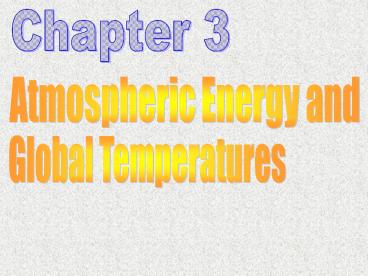Atmospheric Energy and - PowerPoint PPT Presentation
1 / 18
Title:
Atmospheric Energy and
Description:
but highest insolation at surface in subtropical deserts ... in water (photic layer) Water has higher specific heat (same volume can hold more heat) ... – PowerPoint PPT presentation
Number of Views:136
Avg rating:3.0/5.0
Title: Atmospheric Energy and
1
Chapter 3
Atmospheric Energy and
Global Temperatures
2
Energy Exchange
- Energy Input Solar Radiation
- decreases poleward
- reduced in areas of frequent cloud
- total energy input to atmosphere highest at
equator, - but highest insolation at surface in subtropical
deserts - Global Range in Average Annual Solar Radiation
Intensity - lt80 W/m2 in frequently cloudy portions of
Arctic/Antarctic - ?150 W/m2 in Lethbridge (greatest of hours of
sunshine in Canada) - gt280 W/m2 in subtropical deserts
3
- Short-wave Energy Loss
- Albedo
- Proportion of insolation that is reflected (31
global avg.) - Energy may reflect back to space without being
absorbed - Darker colours have lower albedo
- Water low albedo for high solar alitude (calm
seas) - high albedo for low solar altitude (calm
seas) - rough seas moderate this pattern
- Cloud-albedo forcing reduces available solar
energy - Partially compensated by absorption of longwave
energy - emitted by the Earth (cloud-greenhouse forcing)
4
Albedo of Water
5
Scattering Gas molecules, dust particles,
pollutants, ice and cloud droplets scatter
incoming solar radiation. This results in
diffuse radiation Absorption 69 of
top-of-atmosphere solar radiation is absorbed
Earths surfaces (45) Atmosphere (24) Heats
surface or converted to chemical energy in
photosynthesis
6
- Conduction, Convection and Advection
- Conduction
- heat is diffused to cooler material as radiation
absorbed - land heats more quickly than water
- Why ? Thermal mixing and higher heat capacity of
water - Solids (land) are better conductors than gases
(atmosphere). - Convection
- physical mixing with a strong vertical motion in
gaseous or - liquid media
- As land heats up, the air immediately above warms
too - Warm air rises (less dense) while cooler air
falls (more dense) - Advection
- Lateral heat transfer
7
- Energy Output
- Earth Re-radiation (longwave)
- The Earth and its atmosphere emit longwave
radiation - Greenhouse Effect
- Some L? is absorbed by CO2, H2O, CH4, NOx and
- CFCs in the lower atmosphere
- Re-radiated in all directions (some toward Earth)
- Human-Induced Climate Change
- Greenhouse gas emissions (eg. fossil fuel
burning) - Increased absorption of L?
- Effect of Clouds
- High clouds cause cloud-greenhouse forcing
- Low clouds cause cloud-albedo forcing
8
Latitudinal Energy Balance Distribution(Fig 3-10)
Tropics Energy surpluses due to high solar
altitude (incoming energy exceeds outgoing
loss) Mid-latitudes Surpluses and deficits
occur seasonally Deficits dominate (annual
balance at ? 36 latitude) Polar regions Deficit
(outgoing loss exceeds incoming energy gain)
Result Net poleward transport of energy
surplus through atmospheric and oceanic currents
9
Net Radiation Q K? - K? L? - L? (Fig.
3-9) K? is solar radiation incident upon the
surface K? is solar radiation reflected from the
surface L? is infrared radiation reradiated to
the surface L? is infrared radiation emitted from
the surface Net radiation, Q is expended from a
non-vegetated surface through one of three
pathways 1. Latent heat of evaporation (stored
as water vapour) 2. Sensible heat 3. Ground
heating and cooling (zero annually)
10
A lake Notice the low K? values
11
What do you think the surface type is for this
plot ? Why ?
12
Energy at Earth's Surface Daily radiation
pattern is symmetrical Temperature lags behind
insolation curve When would you expect the
coolest/warmest part of the day?
So far today (Sept 10, 2003)
13
Radiation vs. Energy Balance Overall, the
surface receives more K? and L? than it expends
as K? and L? Why does the surface not just get
hotter and hotter ? Energy is expended Sensible
heat (convection and conduction) Latent heat of
evaporation Ground heating at depth
14
L
K? TO SPACE31
L? TO SPACE69
100-31-690
100
Heat transfer 72431 ! Compensates for
radiation imbalance at surface
ABSORPTION
4619469
L?ltK? !!
46-1531
Source NOAA
15
- Temperature
- Measured in degrees Celsius or Kelvin
- Types of Thermometers
- Thermisters
- Thermocouples
- Alcohol Thermometers
- Mercury Thermometers
- Global Climate Observing System
- 15,400 known weather stations worldwide
- Daily mean temperature (average of min and max)
- Monthly mean temperature (average of daily means)
Basis temperature alters electrical resistance
Gill Radiation Shield
16
- Temperature Controls
- Latitude
- Variation in insolation
- Altitude
- temperature decreases with altitude
- Parcel of air expands as pressure reduced
- Mountainous areas are colder than locations near
sea level - Surfaces gain and lose heat rapidly to atmosphere
at high elevation (air is has less mass per unit
area) - Permanent equatorial icefields and glaciers at
high altitude - Snowline closer to the ground with increasing
latitude (and/or - precipitation)
17
- Cloud Cover
- Reflect and absorb solar radiation (surface
cooling) - Absorb, and (re-)radiate longwave radiation
(surface warming) - Overall effect is a slight cooling (mainly low
cloud) - Land-Water Heating Differences
- Ocean energy lost to evaporation
- Heat energy absorbed (latent heat of phase
change) - Land (more heating expended as sensible heat)
- 2. Water is transparent ground is opaque
- Ground absorbs insolation at Earth-Atmosphere
interface
18
- 3. Solar insolation distributed to much greater
depth - in water (photic layer)
- Water has higher specific heat
- (same volume can hold more heat)
- Water movement - mixing spreads heat over a
- greater volume
- Surface waters and deep waters mix































